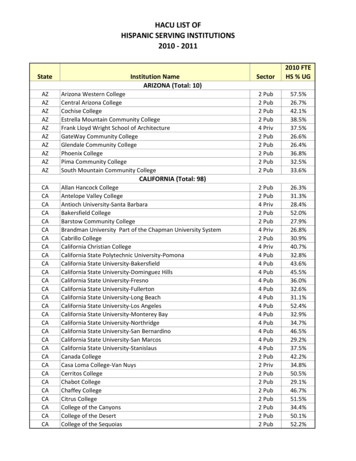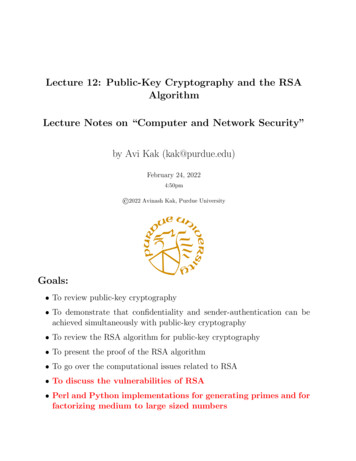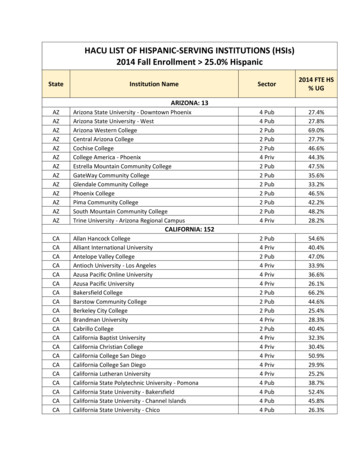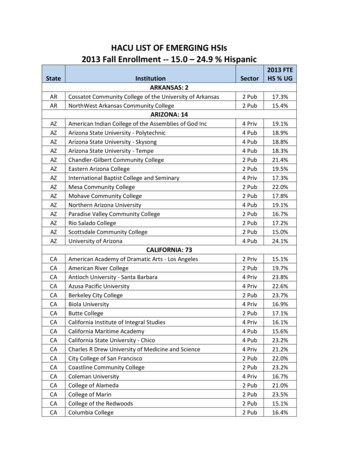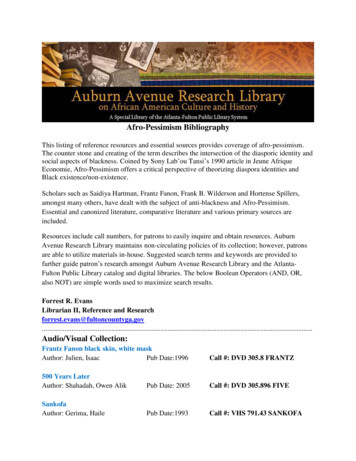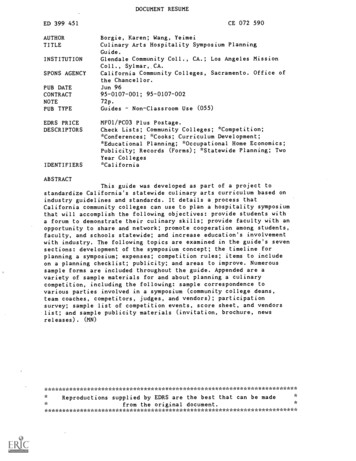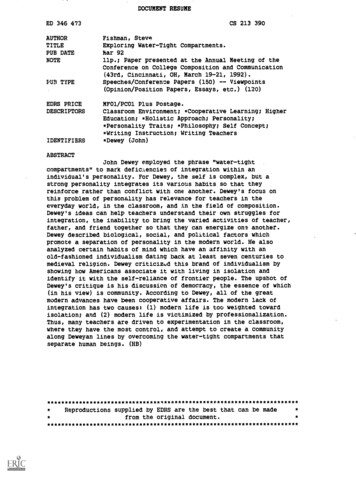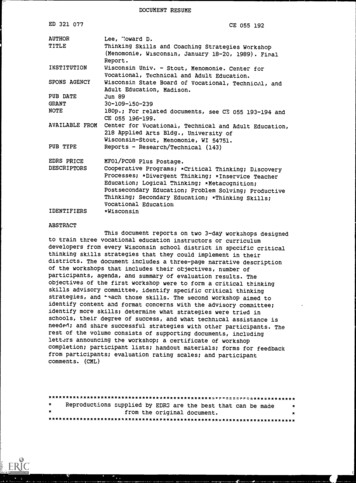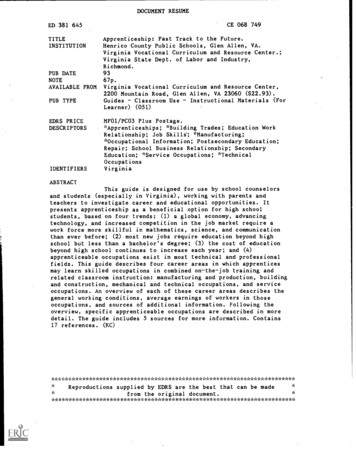
Transcription
DOCUMENT RESUMECE 068 749ED 381 645TITLEINSTITUTIONPUB DATENOTEAVAILABLE FROMPUB TYPEEDRS PRICEDESCRIPTORSIDENTIFIERSApprenticeship: Fast Track to the Future.Henrico County Public Schools, Glen Allen, VA.Virginia Vocational Curriculum and Resource Center.;Virginia State Dept. of Labor and Industry,Richmond.9367p.Virginia Vocational Curriculum and Resource Center,2200 Mountain Road, Glen Allen, VA 23060 ( 22.93).Instructional Materials (ForClassroom UseGuidesLearner) (051)MF01/PC03 Plus Postage.*Apprenticeships; *Building Trades; Education WorkRelationship; Job Skills"; *Manufacturing;*Occupational Information; Postsecondary Education;Repair; School Business Relationship; SecondaryEducation; *Service Occupations; *TechnicalOccupationsVirginiaABSTRACTThis guide is designed for use by school counselorsand students (especially in Virginia), working with parents andteachers to investigate career and educational opportunities. Itpresents apprenticeship as a beneficial option for high schoolstudents, based on four trends: (1) a global economy, advancingtechnology, and increased competition in the job market require awork force more skillful in mathematics, science, and communicationthan ever before; (2) most new jobs require education beyond highschool but less than a bachelor's degree; (3) the cost of educationbeyond high school continues to increase each year; and (4)apprenticeable occupations exist in most technical and professionalfields. This guide describes four career areas in which apprenticesmay learn skilled occupations in combined on-the-job training andrelated classroom instruction: manufacturing and production, buildingand construction, mechanical and technical occupations, and serviceoccupations. An overview of each of these career areas describes thegeneral working conditions, average earnings of workers in thoseoccupations, and sources of additional information. Following theoverview, specific apprenticeable occupations are described in moredetail. The guide includes 5 sources for more information. Contains17 references. **************************Reproductions supplied by EDRS are the best that can be madefrom the original ******************************
tursvU S DEPARTMENT OF EDUCATIONOffice of Educational Reruatch and ImprovementEDUCATIONAL RESOURCES INFORMATIONCENTER (ERIC)This document has been reproduced asWowed from the person or organizationoriginating itO Minor changes have been made to improvereproduction outtlitYPoints of view or opinions stated rn thus documerit do not necessarily repesent officialOCRI position or policy"PERMISSION TO REPRODUCE THISMATERIAL HAS BEEN GRANTED BYTO THE EDUCATIONAL RESOURCESINFORMATION CENTER (ERIC)"hsBEST COPY AVAILABL2
APPRENTICESHIPFAST TRACK TO THE FUTUREDeveloped byVirginia Department of Labor and IndustryApprenticeship Training13 South 13th StreetRichmond, Virginia 23219andVirginia Vocational Curriculum and Resource Center2200 Mountain RoadGlen Allen, Virginia 23060 Virginia Department of Labor and Industry, 19933
DEDICATIONApprenticeship: Fast Track to the Future is dedicated to Teresa AnneSigafoose, Apprenticeship Supervisor, Virginia Department ofLabor and Industry, whose vision and influence helped shape theViginia student apprenticeship program.1938 -19924iii
PREFACEApprenticeship: Fast Track to the Future is designed for use by schoolcounselors and students, working together with parents and teachers toinvestigate career and educational opportunities. It presentsapprenticeship as a beneficial option for high school students, based onfour trends:A global economy, advancing technology, and increased competitionin the job market require a workforce more skillful in math, science,and communication than ever before.Most new jobs require education beyond high school but less than abachelor's degree.The cost of education beyond high school continues to increase eachyear.Apprenticeable occupations exist in most technical and professionalfields.This catalog describes four career areas in which apprentices may learnskilled occupations in combined on-the-job training and related classroom instruction:manufacturing and productionbuilding and constructionmechanical and technicalservice.An overview of each career area describes the general workingconditions, average earnings of workers in those occupations, andsources of additional information. Following the overview, specificapprenticeable occupations are described in more detail.Accompanying the catalog are unbound, one-page job descriptions thatinclude tasks learned by apprentices on the job and concepts and taskslearned in the classroom or lab in related instruction. Counselors mayduplicate these pages for distribution to students, other schoolpersonnel, parents, and interested members of the community.Please direct questions or comments to the Department of Labor andIndustry, Apprenticeship Division, (804) 786-2381.
ACKNOWLEDGMENTSThis catalog was developed in a joint venture by the VirginiaDepartment of Labor and Industry and the Virginia VocationalCurriculum and Resource Center to publicize apprenticeship as a highlybeneficial partnership between Virginia employers and workers intraining. The developers gratefully acknowledge the followingbusinesses and organizations for their generous financial contributionsto the project:American Hofmann Corporation, LynchburgAmerican Safety Razor Company, StauntonAtlantic Research Corporation, GainesvilleCooper Industries, CharlottesvilleE.I. DuPont de Nemours & Co., Filers Division, WaynesboroE.L. Kellogg Corporation, FairfaxEnnis Electric Co, Inc., ManassasGeneral Masonry, Inc , SpringfieldHampton Roads Joint Apprenticeship and Training Committee of theElectrical Industry, Newport NewsHershey Chocolate U.S.A., Stuarts DraftNewport News Shipbuilding, Newport NewsNorthern Virginia Electric Cooperative, ManassasRexnord Corporation, Stuarts DraftRichmond Electricians Joint Apprenticeship Committee, RichmondRoanoke Area Electrical Joint Apprenticeship Committee, RoanokeR. R. Donnolley Inc., formerly Meredith /Burda Graphics, Lynchburgand Greensboro, NCValley Mechanical, Inc., ChristiansburgVirginia Merit Shop Education Foundation, Inc., AlexandriaWESTVACO, Bleached Board Division, Covington.The following apprentices, journey workers, supervisors, and instructors graciously allowed the developers to photograph and interviewthem.From DuPont, Waynesboro (photographed at Valley VocationalTechnical Center, Fishersville):Charles E. Bedall, instructorRichard A. Black, apprenticeLarry N. Breeden, apprenticeDonald P. Clatterbaugh, apprenticeDonald W. Coffey, apprenticeDanny Cork, apprentice.vii6
Wiley J. Craig, apprenticeship coordinator, Valley Vo-TechSterling Durrett, instructorFrederick W. Fitzgerald Jr., apprenticeRonald D. Hanger, apprenticeJohn L. Huffer, instructorCalvin W. Hughes, apprenticeLarry E. Long, instructorEarl A. Riddle, apprenticeJoe B. Rutledge, apprenticeCurtis L. Smith, apprenticeRobert F. Smith Jr., apprenticeWilliam M. Smith, apprenticeRodger Lee Turner, apprenticeFrom Ironworkers Local 28, Richmond:Robert Harmon, journey workerKathy Ramos, apprenticeCatherine A. Renn, journey workerG. G. Renn, journey workerLouis J. Wright, supervisorFrom Jewett Machine, Richmond:Justin Alexander, apprenticeJohn D. Beasley, apprenticeHerman Cooke, plant managerWilliam Englehurt Jr., team leaderMike Fitzgerald, journey workerJohn Livingston, apprenticeAlan Pitt, technicianFrom Lewis Construction, Richmond:Walter R. Martin, supervisorMichael G. Williams, apprenticeFrom Lens Crafters, Richmond:Arlinda Baylor, apprenticeDonna L. Middleton, apprenticeMildred Schultz, supervisorFrom Merck Pharmaceuticals, Elkton:James Hammer, technicianSara Kis ling, technicianThomas J. Hughes, training managerFrom Tobacco Company Restaurant, RichmondMark W. Kimmel, chef and apprentice supervisorRegina B. Lowery, apprenticeMarco C. Shaw, appreliceviii
From William Byrd Press, Richmond:Douglas Fleming, apprenticeShelia D. Johnson, apprenticeCharles B. Jones, training manager.Development of the catalog was coordinated by the staff of the VirginiaDepartment of Labor and Industry:Dr. Thomas E. Butler, Assistant CommissionerRobert Baumgardner, Director, Apprenticeship DivisionGeorge Eanes, Director, Apprenticeship Related InstructionHarry Seay, Apprenticeship Supervisor.Terri Marshall, Coordinator or the Richmond Apprenticeship andWorkforce Information Center, Virginia Employment Commission,supplied valuable information and insight.The catalog wasslesigned, written, and produced by the Virginia Vocational Curriculum and Resource Center (VVCRC), a grant project of theVirginia Department of Education administered by Henrico CountyPublic Schools, Department of Secondary and Adult Education:Margaret L. Watson, DirectorAnita T. Cruikshank, Writer/EditorBen C. Cleary, PhotographerTeresa P. Kieper, Publications Assistant.The photograph of W. R. Phillips on page 9 was provided by NewportNews Shipbuilding. The photograph of electrician apprentices MikeScull and Mike Gault on page 27 was provided by Hampton Roads JointApprenticeship and Training Committee of the Electrical Industry.ix8
CONTENTSPageA Note to School Counselors .1Apprenticeship: Fast Track to the FutureWhat Is Apprenticeship?Who's an Apprentice?Manufacturing and Production Workers .MachinistPrinting Press OperatorSheet Metal WorkerShipfitterTool and Die MakerWastewater Treatment Plant Operator.Welder, Combination .Building and Construction WorkersBrickmason/Stonemason .CarpenterElectricianHeating, Air Conditioning, and Refrigeration Technician .Plumber /PipefitterStructural Steel WorkerSurveyor Technician (Party Chief)Mechanics and TechniciansAuto Body RepairerAuto MechanicBiomedical Equipment TechnicianConstruction Equipment MechanicDiesel MechanicElectrical /Electronics TechnicianMaintenance MechanicMillwrightService and Support ing OpticianOffice Technician .Pharmacy AssistantIs Apprenticeship for 63738.39404143444548495051.5253545561xi9
A NOTE TO SCHOOL COUNSELORSThis catalog is designed to encourage high school students to considerapprenticeship as a beneficial option for postsecondary occupationaleducation. The benefits of apprenticeship reflect current and futuretrends in state and national economic activity and labor marketdemands.70% of future jobs will require education beyond high school but nota baccalaureate degree. The escalating cost of college tuition makesalternative methods of occupational training very attractive.The level of communication and math skills required for theseprofessional and technical jobs is increasing rapidly.The number of expert craft workerspractitioners of skilled tradessuch as masonry and precision machiningis declining. The demandfor qualified workers is much greater than the supply. Apprenticeship is one of the best ways these experts can pass on their tradition ofexcellence and pride in work. Experts agree that America must regainits superiority in the skilled trades in order to compete in a globaleconomy.Employers demand workers who can collaborate with others, solveproblems, adapt to changing conditions, and manage their own jobsand lives outside of work. Student apprenticeshippart-time workas a registered apprentice while in high schoolis an excellent way togain these workplace skills. Cooperative education has long provedthe value of adults as role models for working students.The fastest growing occupations will be in executive, managerial,professional, and technical fields, all requiring the highest levels ofeducation and skill. The biggest growth in numbers will take place inservice industries and occupations. There are apprenticeableoccupations in almost all of these fields.The Virginia Apprenticeship Act allows for apprenticeship to begin atage 16 in most skilled trades. However, Virginia child labor laws doplace some restrictions on employment within certain occupations.Consult the Labor Law Division of the Department of Labor andIndustry (804-786-2386) for further information.The minimum level of education required for entry into apprenticeshipvaries. Most programs require entrants to have a high school diploma orequivalent. However, regardless of the level of education required,apprentices need a firm grounding in reading, writing, and mathematicsall basic to skilled occupations. Courses in algebra, geometry,trigonometry, drafting, physics, and other courses related to the technicaland mechanical occupations are also highly recommended.101
The educational attainment of apprent4 yes has been climbing. Unable tofind suitable jobs in their own fields, college graduates have turnedincreasingly to the skilled occupations for work. This movement mayput the high school graduate at a disadvantage when competing forapprenticeship openings. Employers may choose college graduatesbecause of a perceived potential for management. However, the highschool graduate with relevant vocational background will usually makea favorable impression. Also, some employers prefer high schoolgraduates because these workers are more apt to make a skilled tradetheir lifetime vocation.Students should be cautioned that some of the more popularapprenticeship programs may have a waiting list.TECH PREPTech prep is a systematic program of study that begins in grade 11 andculminates with an associate degree from a community college. AllVirginia community colleges, along with cooperating school divisions intheir service regions, are developing tech prep programs for nonbaccalaureate-bound students. Because apprenticeship-relatedinstruction may be delivered by a community college, it is possible for astudent apprentice to begin working part-time in high school, work fulltime after graduation, and earn an associate degreein machinetechnology, for examplealong with certification as a journey-levelmachinist or tool and die maker.Students should be encouraged to investigate the possibilities of techprep and an associate degree as a logical outgrowth of apprenticeship.To find out more about tech prep and apprenticeship, contact theVirginia Department of Labor and Industry, Division of ApprenticeshipTraining, or the tech prep coordinator for the Virginia CommunityCollege System.WOMEN IN APPRENTICESHIPWomen today are assuming jobs traditionally held by men. Some of themost popular choices include auto mechanic, electrician, and carpenter.Some out-of-school women, however, do not have the skills andknowledge in math or science to enter these lucrative careers. Eitherthey were discouraged from taking these courses or they tried and failedto achieve passing grades. The result is a lack of confidence in theirability to learn.Research by the American Association of University Women shows thatfemale students often learn faster and more easily in one-on-oneinstruction or in small group, cooperative settings. Apprenticeshiptraining, where on-the-job training is individualized and most relatedinstruction classes are small, can offer women an excellent path torewarding career opportunities.211.
All high school students, male and female, should be encouraged to takemath, science, and vocational courses that will expand their opportunities for professional and technical careers. These courses can be interfaced with a tech prep program that directly involves apprenticeshiptraining as the major focus of the program.More information about women and opportunities for nontraditionalemployment is available from the Office of Gender Equity, VirginiaDepartment of Education.JOB DESCRIPTIONSThe jobs described in this catalog are also described on separate,unbound pages. These pages, which include information about relatedinstruction as well as a list of job tasks and apprenticeship requirements,may be duplicated and distributed to students, parents, teachers, schooladministrators, and others.ADDITIONAL RESOURCESThe following five Learning Activity Packages (LAPs) may be helpful tostudents, parents, or school staff interested in specific facets ofapprenticeship:Introducing ApprenticesSelecting a TradeThe Apprenticeship ClassroomApprentices in the WorkplaceWomen in Apprenticeship.The LAPs are available from Fairfax County Schools, Adult andCommunity Education, Pimmit Hills Center, 7510 Lisle Avenue, FallsChurch, VA 22043. They may be requested also from the VirginiaDepartment of Labor and Industry. For copies of the LAPs and otherinformation about apprenticeship, please call the Virginia Department ofLabor and Industry, Apprenticeship Division at (804) 786-2381.123
APPRENTICESHIP:MST TRACK TO THEFUTUREHave you ever pictured yourselfcontrolling robots to make, repair, test,or ship products?making products for everyday usefrom recycled materials?building communities that blend withthe environment?producing energy from renewP.bleresources?building vehicles that will go faster, besafer, and cost less?helping people improve the quality oftheir lives?If you have considered any of these possibilities, you should explore careers inproduction, construction, maintenanceand repair, or service occupations.Virginia employers need skilled workersin occupations ranging from auto bodyrepairer to welder, from biomedicalequipment technician to optician. Theyare willing to pay premium wages toworkers who have "workplace knowhow," or the ability to get the job doneunder highly demanding circumstances.Sara Kisling and James Hammerrepair a pH meter.Because the demand from employers ishigh, the future looks bright for peoplewho want to enter these careers. However, competition is tough.How can you claim one of these careers?Consider apprenticeship: a system ofcombined on-the-job training and relatedclassroom instruction that allows you toearn money while you learn.Want to know more? Turn the page.135
WHAT ISAPPRENTICESHIP?Apprenticeship is a training system underwhich a worker learns a skilled craft ortrade while earning wages.An apprenticeship program may be sponsored by an employer, an association ofemployers, a joint apprenticeship committee, or an organization of employees. Theprogram must be registered with theVirginia Apprenticeship Council.HOW does apprenticeship work?It is based upon a written trainingagreement between the apprentice andthe employer.It consists of on-the-job training andclassroom instruction on the theoriesand concepts related to the occupation.It ends when the apprentice completesthe training, receives a Certificate ofCompletion, and is designated ajourney-level worker.WHAT are the benefits of apprenticeship?Research shows that, compared to informally trained workers, apprenticeship graduates are more educated,work more steadily, learn their jobsfaster, and are more likely to becomesupervisors. They are better skilled,more productive, and work moresafely.,Apprentices earn while they learn.They generally start work at half thewage paid journey workers andreceive regular raises throughout theirTeam leader William Englehurt (1)helps Justin Alexander solve aproblem.'Occur ational Outlook Quarterly. U.S. Bureau ofLabor Statistics, Winter 1991/92, p. 28.147
apprenticeship. According to the Virginia Employment Commission, theseraises can mean a difference of 30,000to an apprentice during a 4-year periodwhen compared to the earnings of anunskilled worker. Apprentices workApprenticeship can begin anytimeafter age 16: Both DonaldClatterbaugh and FrederickFitzgerald have 20 years of workexperience.full time, averaging 40 hours a week,50 weeks a year. For many, valuablebenefits such as health care insuranceand retirement are included.Apprenticeship teaches all aspects of atrade, thereby making workers moreversatile.Apprentices learn to work withdifferent kinds of people in an actualworking situation. These "peopleskills" are highly valued by employers.WHO is eligible for apprenticeship?Most technical occupations requireapprenticesA to be at least 16 years of ageA to have a solid foundation in math,science, and.languageA to have a high school diploma orGED or be working toward a highschool diploma as a studentapprenticeA to be employed by a sponsoringemployer.Apprenticeship programs are open toboth men and women and to allminorities.HOW LONG does apprenticeship last?The length of apprenticeship varies between one and six years, with four yearsof on-the-job training being the average.A certain number of related instructionclasses are usually required for each yearof apprenticeship.158
WHAT ABOUT related instruction?Related classroom instruction usuallytakes place outside of work hours.Apprentices may attend class attechnical schools, community colleges,or in industrial settings.Instructors are often expert journeylevel workers.Classroom topics often include tradetheory, math, science, and language.Concepts of psychology and economicsare also taught. Additional languageclasses such as English as a SecondLanguage are available in some areasof the state.Related instruction may also includehands-on practice of job tasks in acontrolled, safe environment. Safework practices are always taught.At the end of the required course ofstudy, apprentices are awarded a certificate of completion. An apprenticewho maintains an A average and isnominated by his or her employermay earn an honors certificate.The cost of related instruction is theresponsibility of the apprentice. Employers may contribute to theseexpenses.Apprentices in an occupation thatrequires licensing are eligible to applyfor the licensing exam when they havecompleted both their on-the-jobtraining and related instruction.W. R. Philips, Jr., President ofNewport News Shipbuilding andformer apprentice: "The educationreceived by an apprenticestudent . builds confidence, andit provides the ability to adapt andbe flexible."169
WHO'S ANAPPRENTICE?Since 1938 when the state legislaturepassed the Voluntary Apprenticeship Act,Virginia workers have completed morethan 40,000 apprenticeships. Althoughthis catalog describes 31 of the most popular programs in the state, the U.S. Bureauof Apprenticeship and Training recognizes nearly 800 apprenticeable occupations, ranging from accordion maker andactor to winemaker and x-ray equipmenttester. Many people are aware of apprenticeships in the construction andindustrial environments. It is alsopossible to apprentice to be a firefighter,graphics designer, or jeweler.The availability of apprenticeship programs depends primarily on the area ofthe country and the need for trainedworkers. For example, because there islittle industry in Northern Virginia, mostapprenticeships are in the constructionfield. The demand is entirely different inTidewater Virginia, where manymanufacturing and productionopportunities exist.Justin Alexander, John Beasley, andJohn Livingston, shown here withteam leader William Englehurt (1),are preparing for a rewardingcareer in precision machining.As long ago as the Middle Ages, apprenticeship was the most common way forEuropeans to learn a trade. Although themost glamorous example might involvethe squire apprenticed to a knight, craftguilds sponsored a system in which youthwere "indentured" to established craftworkers. When Europeans emigrated toAmerica, they brought with them the system and traditions of crafts and apprenticeship. Famous Americans who wereonce apprenticed includeA George Washington, surveyorA 'I homas Jefferson, nail mak(sr1711
A Benjamin Franklin, printerA Paul Revere, silversmithA Abraham Lincoln, lawyerA Andrew Johnson, tailor.Many of the skilled occupations that arecurrently apprenticeable in Virginia aredescribed on the following pages. Theyare presented in clusters representingmanufacturing, construction,maintenance/repair, and serviceoccupations.Manufacturing/ProductionWorkers . .Building and Construction .Workers . . . . .Mechanics and Technicians .Service and SupportWorkers . .Regina Lowery and Marco Shaware training for one of 800apprenticeable occupations.121813233345
MANUFACTURINGAND PRODUCTIONWORKERSWorkers in production and manufacturing occupations make products fromall kinds of materials, from paper andplastics to light metal alloys and iron. Ifyou become an apprentice in one of thesetrades, you might make parts formachines, build ships, print newspapersand magazines, or produce clean water.Like most heavy industry occupations,these jobs are becoming increasinglycomputer-aided. If you have an aptitudefor computer-related tasks as well as aninterest in highly technical math andscience, the production and manufacturing field offers challenging andrewarding careers.In Virginia, apprentices work in thefollowing production occupations:MachinistPrinting Press OperatorSheet Metal WorkerShipfitterTool and Die MakerWastewater Treatment Plant OperatorWelder.WORKING CONDITIONSAlan Pitt uses CAD to help designmachine parts.Most production workers work in clean,well lighted, and well ventilated shops.However, high-speed machines presenthazards that demand strict attention tosafety and the wearing of protectiveequipment. Some metals can emit toxicfumes as they melt. Some workers areexposed to chemicals and gases that canbe harmful.Production workers usually work a 40hour week but overtime is common1913
during peak production times. Productionshifts require night and weekend work.Many manufacturing firms are organizedaround work teams. Workers make decisions and have responsibilities that usedto belong to middle managers, so theymust be skilled at working with people aswell as machines. Concepts such as 'justin-time" and "zero defect" manufacturingmean that teams must respond quickly tochanges and solve problems in a creativeway.108 OUTLOOKWith the exception of wastewater treatment plant operators, the national demand for production workers will stay thesame or decline slightly through 2005.The primary need is to replace employeeswho are retiring or leaving the workforce.However, employers are currently havingtrouble finding applicants with the required mathematical and mechanicalskills, so excellent oprtunities exist forqualified apprentices.Herman Cooke, plant manager:"Master machinists are a dyingbreed. Unless we train our ownapprentices, we're out ofbusiness."The demand for wastewater treatmentplant operators is expected to grow, although employment opportunities mayshift from local government to privatefirms.EARNINGSNationally, the median hourly wage forjourney-level production and manufacturing workers in 1990 ranged from 10.07for sheet metal workers to 13.92 for tooland die makers.Apprentices start at about 40 to 50 percentof the wage of journey-level workers andreceive periodic raises until they reachfull pay.1420
ADDITIONAL INFORMATIONTo find out more about production andmanufacturing occupations and apprenticeship opportunities in the industry,contact the local Virginia EmploymentCommission job Services Office; theVirginia Department of Labor andIndustry, Division of ApprenticeshipTraining; or the U.S. Department of Labor,Bureau of Apprenticeship and Training.(See page 59 for addresses and telephonenumbers.)John Livingston followed his fatherinto the machine trades.2.1f15
MACHINISTMachinists set up and operate conventional, special-purpose, and numerical controlmachines and machining centers to makeand assemble parts for industrial machinery, aircraft, automobiles, and other manufactured goods. They may make one-ofa-kind or small batches of parts to order.Justin Alexander says that his highschool course in woodworking wasvaluable preparation for machinistapprenticeship.As part of their work, machinistsA determine dimensions and tolerances, operational sequence, andsetup requirements by studyingblueprints, sketches, specifications,or samplesA measure and mark dimensions andreference points on the work-pieceas guides to future machiningA select, align, and secure holdingfixtures, cutting tools, or attachmeni . on machinesA regulate machining factors such asspeed, feed, coolant flow. and depthand angle of cutA adjust machine controls as requiredA verify conformance of finishedworkpiece to specificationsA fit parts into complete assemblyA verify dimensions and alignment ofassembly.BECOMING A MACHINISTGenerally, machinist apprenticeshipsrequire 4 years on-the-job training andrelated classroom instruction.Employers prefer applicants with ahigh school diploma and mechanicaland mathematical aptitudes.Recommended secondary schoolcourses include algebra, geometry,trigonometry, physics, drawing anddesign, and machine shop.162?
PRINTING PRESS OPERATORPrinting press operators set up, operate,and maintain printing presses, performing duties that vary with the typeand size of press. Rotogravure pressesare used to print illustrations for the mostpart, and web presses are primarily usedto print newspapers , books, and periodicals. Large in-line web presses mayrequire several operators on each run.Press operators mayA check job order to find out the kindsof paper and colors of ink to be usedA load the press with paper and inkA start the press and monitor itsoperationA secure printing plates to the printingunit and adjust the tolerancesA run proofs and make adjustmentsA adjust control margins and ink flowto the inking rollersA clean and oil the press and makeminor repairsA clean and reset rollersA set up and operate plate-makingequipment and paper-cutting,drilling, and folding machinesA clean ink fountains; remove, clean,and store plates; clean the printingunit cylinders at the end of the run.Shelia Johnson prepares negativesfor printing.BECOMING A PRINTERPrinter apprenticeship programs require 4 to 6 years of on-the-job trainingand related classroom instruction.Most employers prefer applicants witha high school education with aknowledge of grammar, math,chemis
Virginia Vocational Curriculum and Resource Center.; Virginia State Dept. of Labor and Industry, Richmond. PUB DATE. 93 NOTE 67p. AVAILABLE FROM Virginia Vocational Curriculum and Resource Center, 2200 Mountain Road, Glen Allen, VA 23060 ( 22.93). PUB TYPE Guides Classroom Use Instructional Materials (For Learner) (051) EDRS PRICE MF01/PC03 .
